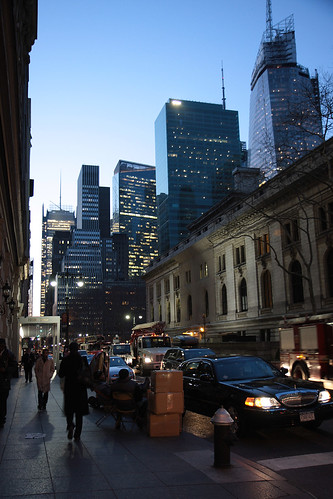
Photo by myself on West 40th Street and Fifth Avenue.
The main branch of the stately New York Public Library is to the right. It's undergoing a slight makeover at the moment. Portions are shrouded by tarps, which bring to mind a Christo installation.
A row of recently constructed modern buildings recede to the distance. The furthest one with the spire is the New York Times building completed last year by noted Argentinian architect Cesar Pelli Italian architect Renzo Piano. (Thanks John, who commented below with the correction!)
In 2000, Fox and Fowle, a New York architecture firm, completed 4 Times Square, the Conde Nast building at Broadway and 42nd Street.
The building caused a buzz because it called itself 'green'. It was the first time I'd heard the term applied to buildings. Special care had been taken in the design of the curtain walls, so a minimal amount of energy would be necessary for heating and cooling. Recirculation of air was also a concern, to avoid unhealthy office spaces.
So much waste is created in the building process, that it's great to know that architects, contractors and clients want to reduce the impact of construction on the environment. The trouble is that many of the costs are higher up front, to provide a savings in energy later.
Architects and designers can be concerned about the environment, but it means nothing until the client is willing to pay for it. And then 'green' alternatives have to be available to choose from.
When buildings began relying on internal steel columns, it marked a huge change in design and aesthetics. The New York Public Library is load bearing masonry building and looks like it is. On the other end of the spectrum, modern high rises don't wish to pretend to be load bearing at all. Their steel and glass facades imply a separate internal skeleton.
Now with the focus on sustainability, I have to wonder how our time period will be viewed in the future. Will we be able to discern a 'green' building from a non-green building by sight? Will there be methods for buildings to code themselves as green, and hence brand themselves as a better, more responsible place to live or work?
Stay tuned.










9 comments:
Beautiful photo. And this brings up an interesting question: how much is done in terms of building environmentally conscious residential housing in NYC? Seems like only doing commercial buildings are half the picture.
Haha, good point.
There is so much to know in terms of this stuff. I am but a fledgling.
In terms of commercial buildings, there are tax incentives toward being green. You accumulate LEED points for different levels you can achieve (gold, silver).
Private residences are a different story. No such tax incentives, which is troubling. Hopefully there will be, soon.
As for the residential high rises there's a recent for developers to brand their buildings as green to attract people. Having gardens on the roof, for instance, absorbs heat and collects run-off water. At the same time, it's a building amenity.
I wonder whether developers want to put in the $ to revamp older buildings. I think they just want to make a buck and skedaddle.
From what I've heard, all things being equal, LEED certification can help set a building apart from the rest. With so many image-conscious companies trying to be good corporate citizens, maybe the market will continue driving the green building trend. But who knows, given the current economic climate?
I love the photo. Great content and lighting.
Great Pic.
I love learning about all the buildings!
j'aime cette série de building, on dirait qu'ils sont juste posées sur les maisons. Bon weekend dans la big city
I like this series of building, it looks like they just put on the houses. Good weekend in the big city
Hi Spandrel
I hope the trend continues.
When architects build, they do so with the intent that the building stays for a while. Why not do it right the first time? I can't fathom the idea of disposable buildings.
Welcome Tam and thank you!
Hi Barber Bunch
I'm glad you're enjoying it and aren't bored, lol.
Hi Olivier
It's funny how similar all the high rises look.
Bon week-end!
I thought 4 Times Square became famous when the construction elevator keeled over and killed that old lady in her bathtub. :)
Just so you know that people are paying attention to what your profession does and what it's up against I want to tell you that I don't know anything about building on any level but I had read about the higher upfront costs and how hard it is to set up a green building. We know you're trying but that ultimately it's up to the developers/builders.
Just a small note. The NY Times building was actually designed by Italian architect Renzo Piano.
Also, on an interesting note, the Times building is also LEED certified, but only in the lower half that the New York Times occupies. Since the building holds their name they are able to call the entire building LEED certified through this loophole.
Post a Comment